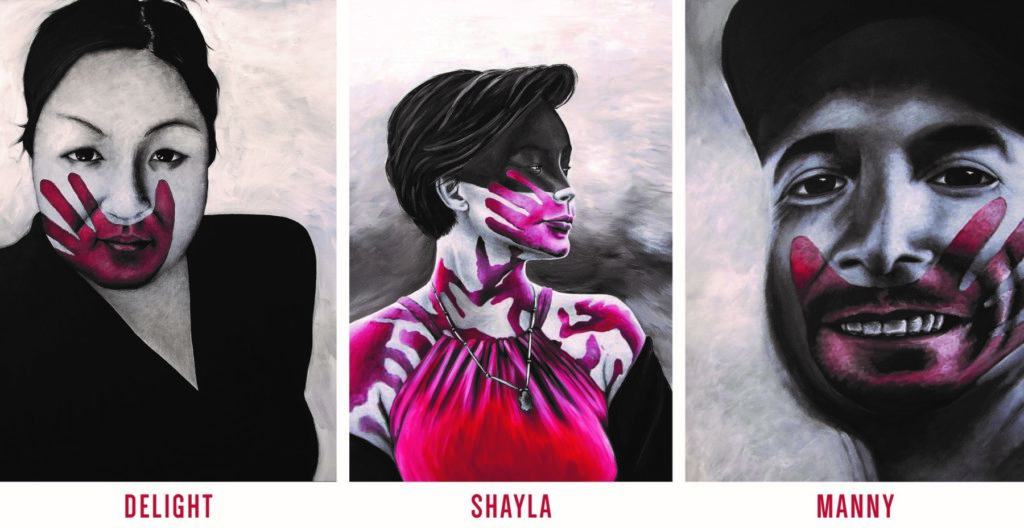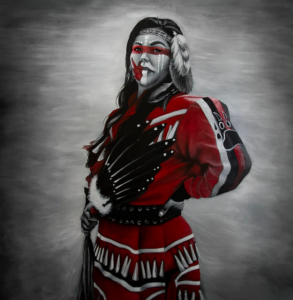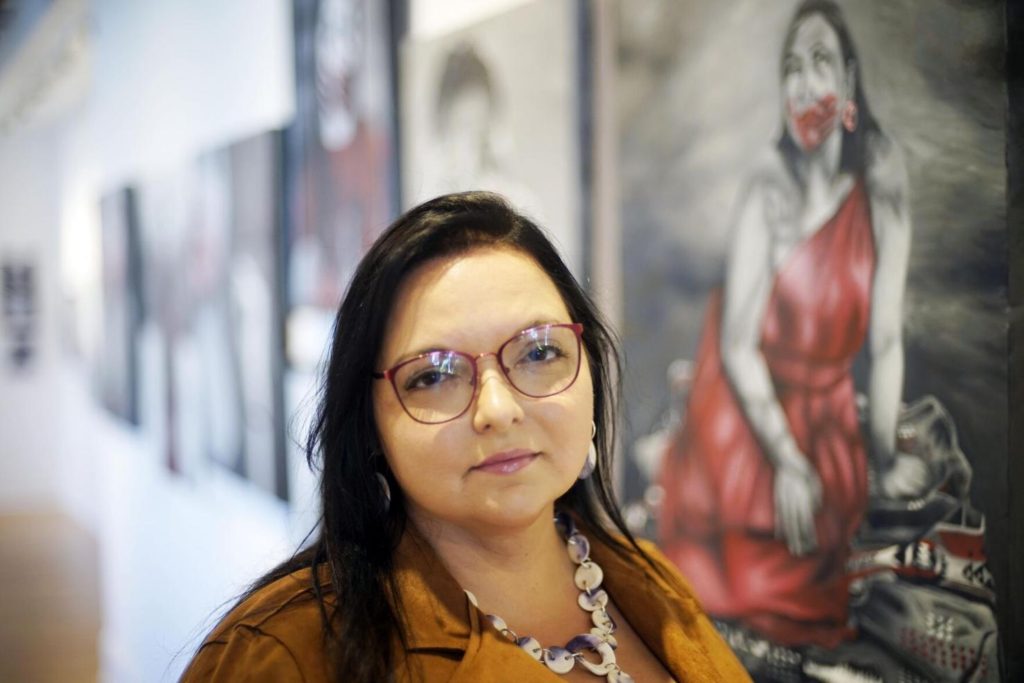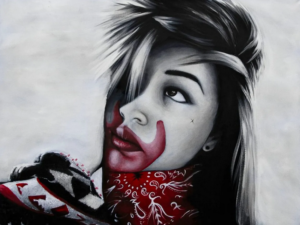
By OREGON ARTSWATCH
NEWPORT — The first portrait came out of a mix of boredom and awe, sparked by a chance online encounter.
Nayana LaFond didn’t expect much attention to the portrait she painted — a selfie of a woman wearing red in support of missing and murdered Indigenous people. But overnight, the portrait shared on Social Distance Powwow drew more than 2,000 hits, and LaFond found herself with an unexpected calling that has since all but consumed her life.
Forty portraits from LaFond’s “Portraits in RED” series will be on display beginning Thursday at the Pacific Maritime Heritage Center in Newport. All are of missing or murdered Indigenous people or members of their families. Two of the portraits are of missing members of the Confederated Tribes of Siletz Indians.
“Portraits in RED” will be on exhibit from Thursday, Feb. 2 to May 7 in the Pacific Maritime Heritage Center. An opening reception from 4-7 p.m. Thursday will include a Confederated Tribes of Siletz Indians blessing ceremony.

Since that first painting in May 2020, LaFond has painted more than 100 portraits. The first painting came about on May 5 – National Day of Awareness for Missing and Murdered Indigenous Women – when LaFond saw the selfie of Lauraina Bear of Saskatchewan wearing a vivid red sweater and the red handprint across her mouth that symbolizes solidarity with missing and murdered Indigenous people.
Inspired, LaFond asked to paint her, thinking it would be a contribution, but also catharsis for herself. LaFond, who lives in Massachusetts and is of Anishinaabe, Abenaki, Mi’kmaq, and Metis descent, is a victim of domestic violence, as were her mother and grandmother.
After the first painting, LaFond, sticking close to home like many during the Covid pandemic, thought she’d do just one more. Already an established artist, her series of paintings of health care workers was featured in New York’s Times Square in 2020, as well as in news venues in Austria and Germany. But when the second painting drew more than 3,000 hits, she knew she couldn’t give it up just yet.
“It snowballed,” LaFond said. “I thought OK, I’m still stuck at home; I have these random canvases around the house; I’ll make a post asking if anyone associated with a missing or murdered Indigenous person would like me to paint them. I was thinking, I’ll get five to 10. I got 25 the first day. I very quickly realized I couldn’t cherry-pick them. It didn’t feel right to say this one is not as attractive as that one.… I’ll paint all of them. This 25 would be it, but they didn’t stop coming.”

Portraits from family photos
LaFond paints the portraits from pictures the subjects send. Each portrait features a red handprint, which symbolizes being silenced. The color red is also meant to call home the dead, because some native cultures believe red is the only color spirits can see.
“That’s specifically why they are painted in black and white, plus anything on them that was red, plus the red hand,” she said. “I want to paint them the way the spirits would see them.”
She doesn’t take money from the families for the paintings — she says that would be immoral — but gives the portraits to the families. With the family’s permission, she sells prints, using the money only to cover the cost of the paintings.
“I don’t want to profit from this, but I would like it to be eventually self-sustaining.” She’s also had to deal with people stealing her images, T-shirts and posters being the most popular, usually by vendors outside the U.S.
According to the National Crime Information Center, 5,712 Indigenous women were reported missing in 2016 through the U.S. Department of Justice’s federal missing persons database. However, only 116 of those cases were logged by NamUs, the national clearinghouse and resource center for missing persons.
Portraits in the Newport exhibit include one of a Dakota Sioux woman named Joanne Boha holding her newborn son. The son, now an adult, contacted LaFond and explained it is the only photo he has of his mother.
“She was found murdered in 1976 with him next to her lifeless body,” LaFond said. “To talk to him about it and hear his story, that was humbling.”
Another features a missing 17-year-old from Omak, Wash. Their name is Esmeralda “Kit” Mora.
“It is heartbreaking to hear the circumstances of Kit being two-spirited, the indigenous word for trans,” LaFond said. “With Kit’s piece, I spent a lot of time talking to their family. That always kind of brings it home to me.”
Missing Siletz women

Missing members of the Siletz Tribe are Delight Attebury and Manuel “Manny” Bayya. Attebury’s family last had contact with her in 2019. She was 40 years old and in the Los Angeles area. Bayya was last seen in the Elmira area west of Eugene last March.
Members of the Siletz Tribe welcome the exhibit as an opportunity to educate and raise awareness about the missing and murdered Indigenous people, said Miranda Williams, executive director at the Siletz Community Health Clinic. It’s also a way to get word out that there are resources to help families heal.
“I was really taken aback by the art,” Williams said. “It really takes your breath away.”
When possible, LaFond paints the subjects in traditional portrait style, with a centered subject and blurred background, a style most people understand conveys a sense of importance.
“We have been trained to associate that with kings and dukes and people worthy of that status,” LaFond said. “I came to the realization that I, as a victim of domestic violence, was almost one of them (a murdered Indigenous person). I was intubated and ventilated and on life support. I had to ask myself, ‘How I would want to be represented?’ I would want to be represented with dignity. A lot of these people are being blamed for their own murders.”
Today, the “Portrait in RED” series consumes about 70 percent of LaFond’s creative time, and she plans to see it through for as long as it takes, possibly the rest of her life.
“Right now, my mission is to paint all that are sent to me,” LaFond said. “I want to really have people connect with the subject matter and to honor each of these people, to elevate them to a status of someone who is important and worthy of being remembered. A lot of these cases are just forgotten and treated as if these people are not worth remembering. So, I really want to give them that time out of my day, that energy, and say, you are worth that.”
- This story was originally published by our community partner Oregon ArtsWatch. It is supported in part by a grant from the Oregon Cultural Trust, investing in Oregon’s arts, humanities and heritage, and the Lincoln County Cultural Coalition. For more arts news coverage go to Oregon ArtsWatch.


